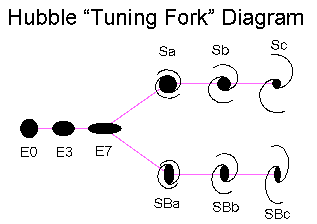

|
Astronomy 162:
Introduction to Stars, Galaxies, & the Universe
Prof. Richard Pogge, MTWThF 9:30
|
Lecture 27: Spirals & Ellipticals & Irregulars
(oh my!)
Readings: Ch 26, section 26-3
Key Ideas:
- Hubble Classification of Galaxies
- Spirals (Ordinary & Barred)
- Ellipticals
- Irregulars
- Differ in terms of
- Relative Stellar & Gas content
- Star Formation Histories
- Internal Motions
- Dwarf Galaxies
Hubble Classification of Galaxies
All bright galaxies fall into one of three broad classes
according to their shape:
- Spiral Galaxies (~75%)
- Elliptical Galaxies (20%)
- Irregular Galaxies (5%)
Basic classification system developed by Hubble (1926 & 1936).

Type E: Ellipticals
Show little internal structure:
- Elliptical in shape
- No disks, spiral arms, or dust lanes
- Brightest stars are red
Classified by the degree of apparent flatness:
- E0 is circular
- E7 is flattest (~3:1 aspect ratio)
Some images of Ellipticals
Type S: Ordinary Spirals
Classified by relative strength of the central bulge & tightness
of the spiral arms
Types: Sa, Sb, and Sc
- Sa: strong bulge & tight, indistinct arms
- Sb: intermediate type
- Sc: small bulge & loose, well-defined arms
Some images of Ordinary Spirals
Type SB: Barred Spirals
Parallel group to the ordinary spirals:
- About as many barred as ordinary spirals.
Feature a strong central stellar bar:
- Bar rotates as a unit (solid body rotation)
- Spiral arms emerge from the ends of the bar
Same subclasses:
The Milky Way is thought to have a weak bar, and is classified
by some as SBbc (part way between SBb and SBc), though this is
still a matter of some controversy.
Some images of Barred Spirals
Type I: Irregulars
Show an irregular, often chaotic structure.
Little evidence of systematic rotation.
Catch-all class:
- Proposed systematic subclasses, but many irregulars defy classification.
Significant dwarf irregular population, classified as "dI"
Some images of Irregular Galaxies
Spiral Galaxies
Properties:
- Mass: 109 - 1012 Msun
- Diameter: 5 - 50 kpc
- Luminosity: 108 - 1011 Lsun
Structure & Dynamics:
- Disk + Spheroid
- Supported by relatively rapid rotation, but spheroid is puffed
up by random motions.
Elliptical Galaxies
Properties:
- Mass: 105 - 1013 Msun
- Diameter: 1 - 200 kpc
- Luminosity: 106 - 1012 Lsun
Structure & Dynamics:
- Spheroid of old stars with little gas or dust
- Supported by random motions of stars with some very slow rotation
Irregular Galaxies
Properties:
- Mass: 106 - 1011 Msun
- Diameter: 1 - 10 kpc
- Luminosity: 106 - few x 109 Lsun
Structure & Dynamics:
- Chaotic structure, lots of young blue stars
- Moderate rotation in Irregulars, but very chaotic motions
as well.
Relative Stellar & Gas Content
Spirals:
- Range is ~10-20% gas
- On-going star formation in the disks
- Mix of Pop I and Pop II stars
Ellipticals:
- Very little or no gas or dust
- Star formation ended billions of years ago
- See only old Pop II stars
Irregulars:
- Can range up to 90% gas
- Often a great deal of on-going star formation
- Dominated by young Pop I stars
Dwarf Irregulars:
- Very metal poor (<1% solar)
- Forming stars for the first time only now.
Dwarf Galaxies
Low-luminosity Ellipticals & Irregulars.
- Significant number of dwarfs
- Most common type of galaxy by number
There are no (convincing) Dwarf Spirals.
Possibilities:
- Small versions of their larger cousins
- Different population of objects despite their superficial similarities
to larger E's and Irr's
Cosmic Building Blocks
Galaxies of all types are the basic "units" of luminous matter in the
Universe.
- Basic units of larger, organized structures
- Sites of star formation from raw gas
- Factories that synthesize heavy elements from Hydrogen & Helium
Differences in the types of galaxies reflect the difference in their
formation histories and environments.
Return to [
Unit 4 Index
|
Astronomy 162 Main Page
]
Updated: 2006 February 12
Copyright © Richard W. Pogge, All Rights Reserved.


